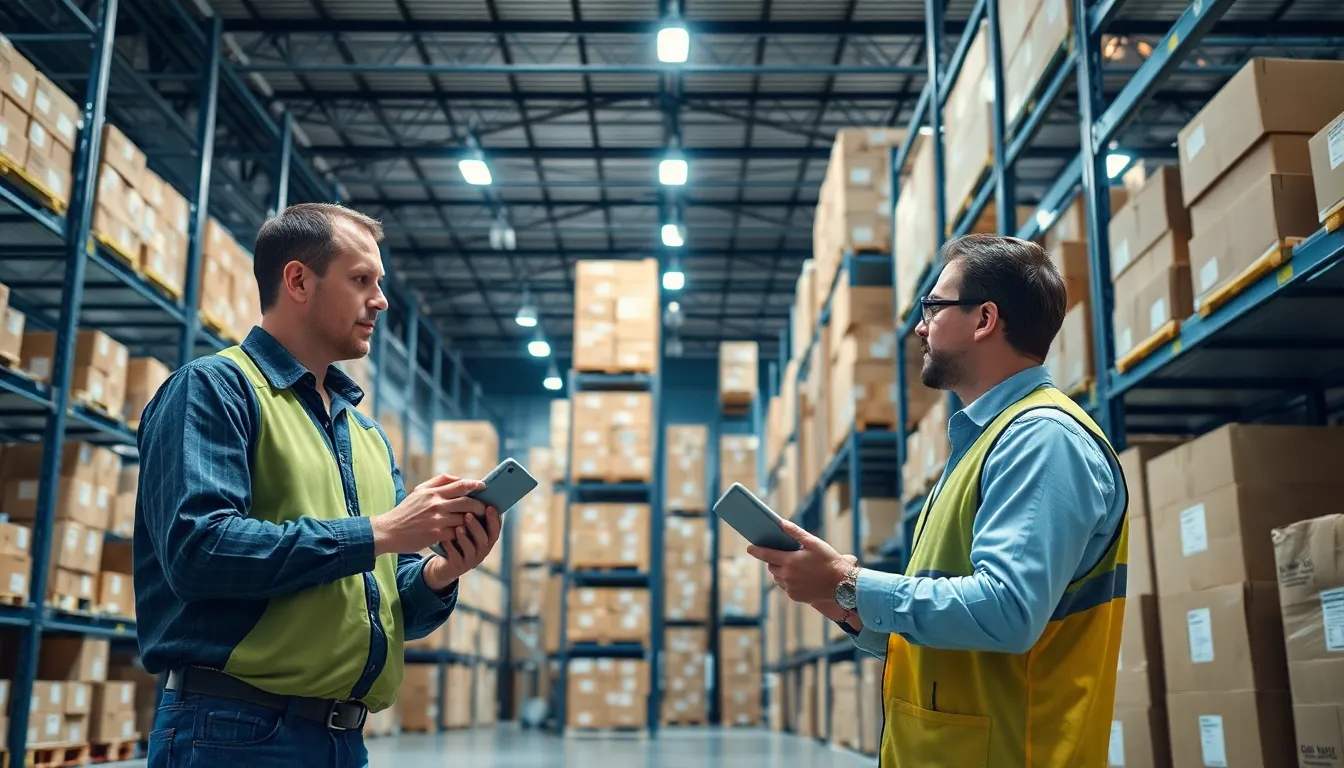In a world where everything from your fridge to your fitness tracker is connected, why should warehouses be left behind? Enter IoT warehouse monitoring—the superhero of inventory management. Imagine a system that keeps an eye on your stock while you sip coffee and contemplate life’s mysteries. Yes, it’s that good!
Table of Contents
ToggleOverview of IoT Warehouse Monitoring
IoT warehouse monitoring revolutionizes inventory management through technology integration. This system enhances efficiency, allowing businesses to maintain optimal stock levels.
Definition and Importance
IoT warehouse monitoring involves using connected devices to track inventory in real-time. Sensors and software facilitate automatic data collection, improving accuracy in stock levels. Real-time insights increase operational efficiency, which leads to better decision-making. Reduced human error significantly enhances inventory management processes. This technology streamlines operations and minimizes costs, crucial for modern businesses aiming to stay competitive.
Key Technologies Involved
Several key technologies drive IoT warehouse monitoring. RFID (Radio Frequency Identification) tags allow for automatic tracking of products, eliminating manual entry. Cloud computing supports data storage and remote access, enabling real-time monitoring from anywhere. Wireless communication protocols such as Wi-Fi and Bluetooth facilitate seamless device connectivity. Advanced analytics tools analyze collected data, providing insights for inventory optimization. Machine learning algorithms also predict stock levels based on historical data, enhancing decision-making capabilities. Together, these technologies create a robust framework for efficient warehouse management.
Benefits of IoT Warehouse Monitoring

IoT warehouse monitoring offers significant advantages that transform inventory management and streamline operations. This technology enhances overall effectiveness and decision-making capabilities throughout the warehouse.
Improved Inventory Management
Enhanced tracking provides real-time visibility into stock levels. Efficiently monitoring inventory minimizes stockouts and overstock situations, reducing carrying costs. Sensors and RFID tags transmit data continuously, enabling accurate counts and automated replenishment. Automated notifications alert personnel to discrepancies, helping mitigate human error. Managers benefit from detailed insights that inform purchasing decisions and demand forecasting.
Enhanced Operational Efficiency
Optimized processes emerge when IoT devices facilitate seamless communication across the supply chain. Improved accuracy eliminates unnecessary delays caused by manual entry and inventory checks. Data analytics offer insights into workflow patterns that identify bottlenecks. Staff productivity increases as manual tasks become automated, allowing focus on higher-value activities. Cost-effectiveness improves through reduced wastage and enhanced resource allocation.
Challenges in Implementing IoT Warehouse Monitoring
Implementing IoT warehouse monitoring presents significant challenges that organizations must address to realize optimal benefits.
Data Security Concerns
Data security poses a critical challenge in IoT warehouse monitoring. Breaches can compromise sensitive inventory data, affecting both operations and customer trust. Safeguarding data during transmission often requires advanced encryption methods. Vulnerabilities in connected devices increase the risk of unauthorized access. Organizations must remain vigilant about updating software and firmware. Regular security audits help identify potential weaknesses. The integration of robust cybersecurity measures fosters a secure environment for data transmission. Compliance with industry regulations, such as GDPR or HIPAA, adds another layer of complexity in managing sensitive data.
Integration with Existing Systems
Integration with existing systems presents additional hurdles in adopting IoT warehouse monitoring. Compatibility issues may arise when connecting new IoT solutions with legacy systems. Staff training becomes necessary to ensure effective usage of updated technologies. Streamlining data flow between platforms demands careful planning and execution. Additionally, resisting disruptions during the transition is vital for ongoing operations. Costs associated with integration can also strain budgets. However, employing middleware solutions can facilitate smoother interfaces between diverse systems. Ensuring cohesive functionality across platforms enhances overall efficiency and minimizes downtime.
Case Studies of Successful Implementations
Successful implementations of IoT warehouse monitoring highlight its transformative effects on inventory management and operational efficiency. The following examples illustrate how different companies leverage this technology to achieve significant improvements.
Example 1: Company A
Company A, a leading retailer, adopted IoT warehouse monitoring to enhance inventory accuracy. By utilizing RFID tags and real-time tracking, it reduced stock discrepancies by 30%. Automated notifications generated alerts for low stock levels, allowing timely replenishment and preventing out-of-stock situations. Consequently, overall carrying costs dropped by 15%. This initiative led to increased customer satisfaction due to the availability of products and streamlined operations.
Example 2: Company B
Company B, a major logistics provider, implemented IoT sensors to gain real-time insights into storage conditions. These sensors monitored temperature and humidity in the warehouse, ensuring optimal conditions for perishable goods. The introduction of data-driven analytics helped identify supply chain bottlenecks, increasing workflow efficiency by 25%. After deploying this system, Company B reported a 40% reduction in waste due to spoilage, significantly enhancing its bottom line.
Future Trends in IoT Warehouse Monitoring
Future trends in IoT warehouse monitoring focus on enhancing efficiency and accuracy in inventory management through technological advancements. Integrating smart technology continues to evolve, bringing innovative solutions to warehouses.
Integration with AI and Machine Learning
Integration with AI and machine learning algorithms enhances decision-making processes. These technologies analyze vast amounts of data collected from IoT devices, helping to predict demand patterns more accurately. Companies can utilize this predictive capability to optimize stock levels and reduce wastage. Intelligent algorithms facilitate automated restocking procedures, ensuring supplies are always available without excessive inventory. Additionally, AI-powered analytics identify inefficiencies in operations, enabling timely adjustments that improve workflow and productivity.
Evolution of Sensor Technologies
The evolution of sensor technologies plays a crucial role in IoT warehouse monitoring. New sensors provide more precise data on inventory conditions, enhancing real-time visibility. Temperature and humidity sensors ensure perishable goods are stored under optimal conditions, minimizing spoilage. Advanced sensor technologies also include weight sensors that allow for accurate tracking of inventory levels without manual checks. These improvements streamline processes and ensure accurate reporting, significantly contributing to the reliability and efficiency of warehouse operations.
The integration of IoT warehouse monitoring is reshaping the landscape of inventory management. By leveraging real-time data and advanced analytics, businesses can enhance efficiency and reduce costs significantly. As organizations navigate the challenges of implementation, including data security and system integration, the potential benefits far outweigh the hurdles.
Successful case studies demonstrate that companies can achieve remarkable improvements in accuracy and operational efficiency. Looking ahead, the continued evolution of IoT technology promises even greater advancements. Embracing these innovations will be crucial for businesses aiming to stay competitive in an increasingly data-driven market.





